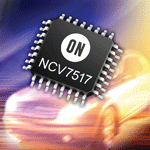Here are the latest products — ICs, boards, connectors and sensors — for use in designs for the automotive and transportation market.
The Infineon Technologies (www.infineon.com) TC17xx AUDO FUTURE family of 32-bit MCUs targets high-performance vehicle powertrain applications and next-generation requirements for reduced fuel consumption and lower emissions. The TriCore processor-based ICs provide a scalable solution that allows the use of the same development environment for cost-optimized entry-level vehicles and high-performance engines and ranges from the 80-MHz TC1736 with 1 Mbytes of flash, to the 180-MHz TC1797 with 4 Mbytes of flash and an integrated FlexRay controller, and havewith a wide range of on-chip peripherals integrated into each MCU.
Infineon’s family of radar system ICs (RASIC) enables automotive radar systems, covering distances between 20 and 200 m in front of a vehicle. The first device in the family, the RXN7740, is a front-end chip for the 76 to 77-GHz frequency range that includes oscillator and power amplifier functional blocks and four mixers for multiple antennas. The chip uses SiGe technology and enables vendors to shrink their radar systems by oneto a quarter of the current size while and reduceing system costs for the RF module by more than 20%.
Melexis (www.melexis.com) has a new automotive optical switch, the MLX75303, a light-to-frequency converter, the MLX75304, and a light-to-voltage converter, the MLX75305. These monolithic sensors bundle a photodiode, a transimpedance amplifier, and an output transistor to reduce noise and minimize the number of external components. All three sensors comply with AEC-Q100 automotive specification and operate at up to 125°C.
ON Semiconductor’s (www.onsemi.com) 150-mA LD0 regulator with reset and delay time select, the NCV8660, features quiescent currents as low as 25 µA typ, with or without a load, which make it ideal for applications complying with the latest 100-µA automotive module requirement. It has a 5.0-V ±2% output and is packaged in DPAK-5 with a budgetary price of $1.38.
ON Semiconductor also has a triple half-bridge driver, the NCV7703, that targets automotive and industrial motion-control applications. Each of the three half-bridge drivers has independent control, allowing for high-side, low-side, and H-bridge control configurations. H-bridge control configuration provides forward direction, reverse direction, braking, and high impedance states. The drivers are controlled via a standard SPI, packaged in SOIC-14, and have a budgetary price of $1.75.

ON Semiconductor’s NCV7517 six-channel MOSFET predriver is controllable by a combination of serial SPI and parallel inputs. It features programmable fault management modes and allows power-limiting PWM operation. It is available in a QFP-32 package at a budgetary price of $1.50.
The L5961 from STMicroelectronics (www.st.com) is the industry’s first integrated power-management solution for MOST (Media Oriented Systems Transport) networks. Designed in cooperation with SMSC to work with that company’s MOST network processors, the L5961 includes apower supply, MOST-compliant power-management control logic, diagnostics, and full system monitoring. The device is priced at $3 ea/1,000. Engineering samples are available now.

STMicroelectronics’ Cartesio automotive-grade application processor System-on-Chip (SoC), with embedded GPS for navigation and telematics. is to be implemented inside several products from Garmin. The Cartesio STA2062 integrates a 32-bit ARM core andwith a high-sensitivity 32-channel GPS subsystem and a set of connectivity peripherals, including CAN, USB, UARTs, and SPI. It also provides on-chip high-speed RAM and real-time clock functionality and is housed in a 16 x 16 x 1.4-mm LFBGA package. The chip is priced below $10 in volume.
ITT Interconnect Solutions (www.ittcannon.com) has developed a junction box assembly solution for mass-transit applications. ITT’s VEAM junction box contains a complete harnessing system, including terminal blocks, cables and electrical components for intervehicle connections as well as power and signal connections. The junction box and its components target control switchboard connections between vehicles, tilting systems, CCTV equipment, intervehicle connections, power and signal connections, and motor supplies up to 660 A. They are approved to IP 66 standards, and power contacts on the components are rated to 400 A. Lead time is 8 to 12 weeks.
Lattice Semiconductor (www.latticesemi.com) recently announced that automotive versions of its Power Manager II programmable mixed signal product family, the ispPAC-POWR1014 and ispPAC-POWR1014A, have been characterized and qualified to meet the certification requirements of the AEC-Q100 standard as defined by the Automotive Electronics Council (AEC). The ispPAC-POWR1014 device replaces power management functions typically requiring multiple ICs, including the reset generator, voltage supervisor, and sequencer. The POWR1014A device integrates a 10-bit A/D converter for voltage measurements. Production quantities are available now.
The FDMS2380 dual solenoid driver from Fairchild Semiconductor (wwww.fairchildsemi.com) integrates multiple control and power semiconductor die into a space-efficient package optimized for automotive and industrial solenoid applications. This intelligent dual-independent-channel low-side driver with built-in recirculation and demagnetization circuits is designed for driving inductive loads. The device is housed in an 8 x 12-mm PQFN package.
The HAL 2810 from Micronas (www.micronas.com) is said to be the first linear Hall-effect sensor to include a programmable microcontroller and a LIN bus 2.0 interface. The device is a smart sensor, integrating the sensing element, all necessary compensation functions, digital signal processing, and full LIN bus connectivity. This reduces system cost and increases reliability, a key feature in networking automotive systems.
The sensor is said to be ideal to replace potentiometers in automotive applications. It offers 12-bit resolution and features both spinning-current and second-order temperature compensation over a range of –40° to 140°C.
DriveCam (www.drivecam.com) uses Texas Instruments DSPs, analog components, MSP430 MCU, and TRF7961 RFID technologies in its behavior-based risk mitigation solution, which predicts and prevents risky driving behaviors that would likely result in collisions. Its latest design, a windshield-mounted camera module, monitors and records the driver’s activities. The video is then uploaded to remote servers for analysis, which will allow the receiver to notify the driver’s manager if a risky behavior has been determined.
Actel (www.actel.com) has achieved ISO/TS16949 certification, which means that it is officially compliant with one of the most demanding quality management system specifications in the world for suppliers to the automotive industry. ISO/TS 16949:2002 is a technical specification that defines the quality management system requirements for the design, development, production, and, when relevant, installation and service of automotive products.
Jim Harrison
Advertisement
Learn more about Electronic Products Magazine





